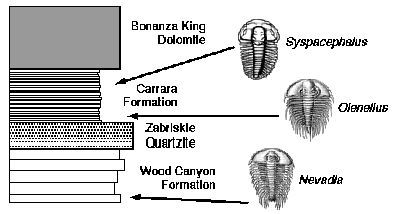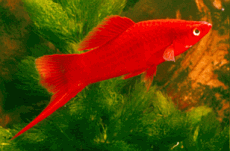
Fall 1999
Lecture Exam 2--KEY
[Note -- On this key, any explanations that I have added to the correct answers
are in brackets.]
This exam consists of 50 multiple-choice questions. Each one has
only one right answer.
Read each question and all possible answers carefully before
answering! Mark your answers on the Scantron form provided, using
only a #2 lead pencil. If you erase an answer, make sure you erase
it completely, or the machine may mark it incorrect. Check carefully
to ensure that your answers are on the correct rows on the Scantron
form.
Turn in both the Scantron form and the test paper
when you are finished. Make sure your name is on both. You may
write on the test paper if you wish, but anything you write on
the test paper will not be graded.
Good luck.
Imagine that you have a pet budgerigar, or "budgie",
(a type of tropical bird often kept as a pet) with green feathers.
Your neighbor happens to have a blue budgie of the opposite sex.
When your neighbor goes on vacation, you offer to keep his blue
budgie in your own home. The inevitable happens, and before you
know it, you have a whole nest of bouncing baby budgies on your
hands.
1. Suppose that all the baby budgies grew up to be a bluish-green
color, somewhere in between the colors of their parents. The simplest
explanation for this would be
incomplete dominance
2. As it happens, all the baby budgies grow up to be green.
This suggests that
the green allele is dominant over the blue allele
3. Suppose you keep one of these green baby budgies, and
when it's grown, you mate it with a blue budgie. How many of the
resulting offspring should have blue feathers?
one-half
You raise all the green baby budgies to adulthood, and then something horrifying happens: One of them mates with his sister! However, since you're in Arkansas, you know how to deal with this situation. And so you dutifully raise all of the resulting chicks.
4. What would you call this generation of budgie chicks?
the F2 generation
5. About how many chicks in this generation will grow up
to have blue feathers?
25%
6. Much to your surprise, one of the chicks grows up to
have pure white feathers. What's probably happened here?
mutation
7. A pet store owner tells you that white budgies are rare
and valuable, while green and blue budgies are quite ordinary.
You promptly set most of your green and blue budgies free, and
breed your white budgie until it collapses from sheer exhaustion.
Any offspring that are white, you also save for breeding. After
some years, you have a large flock of white budgies, which you
sell for top prices. What have you done?
artificial selection
8. A rival of yours tries to imitate your success. He tries
taking some ordinary green budgies, dipping them in bleach until
they turn white, and then breeding them, hoping that the white
color will turn up in their offspring. What he is hoping will
be true?
Lamarckian inheritance
9. Imagine that the green and blue budgies that you got
rid of survive and breed freely in the wild, but are hunted and
eaten by hawks, eagles, and owls. Green budgies blend in well
with green foliage, but blue budgies stand out more, and so are
much easier targets for predators. What will happen over several
generations?
blue budgies become rare due to natural selection
10. Coconut trees produce only a few seeds each year. Each
seed is protected by a thick seed coat and richly supplied with
nutrients that will sustain a growing embryo for a long time.
Therefore, coconut trees are
K-selected organisms
[Yes, plants can be r-selected or K-selected too, and don't you forget it!]
11. Which scientist is credited with developing the modern
principles of uniformitarianism?
Lyell
Marfan's syndrome is an inherited disorder in humans, caused
by a single allele that follows Mendel's laws. People with Marfan's
syndrome tend to be tall and slender, with long limbs, long fingers
and toes, flat feet, and poor eyesight. (Abraham Lincoln may have
had it.) Because of their height, some people with Marfan's syndrome
have become champion basketball or volleyball players (such as
U.S. Olympic volleyball player Flo Heyman, whose team won the
silver medal in 1984). However, people with Marfan's syndrome
also tend to develop heart and blood vessel abnormalities, and
may die suddenly when major blood vessels burst. (Flo Heyman died
at 31 from a burst aorta.)
Questions 12-17 refer to this pedigree of a family with a history
of Marfan's syndrome. A black dot indicates a person who has or
had Marfan's syndrome. A question mark indicates that it's not
certain whether a person has the syndrome.
[Questions 12 and 14-17 were DELETED from the grading. The
pedigree on the exam is ambiguous: it could have been interpreted
in more than one way.]
13. Person E is
a female
[Represented by a circle on the pedigree chart]
18. Your eyes and an insect's eyes both have the same function,
but their structures are radically different. This makes them
analogous
19. About 240 million years ago, the Earth's continents
were clumped together in a single supercontinent called
Pangaea
20. In the graph on the right, what does N stand
for?
population size
21. What does the dashed line labeled K represent?
carrying capacity
22. What type of curve is shown on the graph?
sigmoid
23. Evolution
amounts to change over time
24. All of the nutrient cycles depend in some way on the
sun - but which of these cycles is most directly driven by the
sun's energy?
hydrologic (water) cycle
If you come with me one summer and drive out to the Nopah Mountains
in southeastern California, in the Mojave Desert, and hike around
in the right areas, you'll find the layers of rock that are represented
in the following diagram. Search in these layers, and you'll find
fossils of arthropods called trilobites. Typical trilobites
from the Nopah Mountains are shown on the right of the diagram.
Questions 25-31 refer to this diagram.

25. As far as you can tell from this diagram, which layer
is the oldest?
Wood Canyon Formation
26. What factors should be watched for, because they could
potentially make it difficult to tell which layer is oldest?
all of the above
27. The fact that you find different trilobites in different
layers illustrates
the principle of succession
28. Trilobites are no longer alive on Earth, as far as
we know. Who was the first to document thoroughly that many animal
species have gone extinct?
Georges Cuvier
29. Geologists have determined that the Wood Canyon Formation
is about 540 million years old. What primary method did they use
to arrive at this absolute age?
radiometric dating
30. What "great moment in evolution" was taking
place around the time the Wood Canyon Formation was formed?
radiation of animals with hard shells
[540 million years ago, as you know from question 29]
| 31. Part of the Wood Canyon Formation includes rock surfaces with a polygonal pattern of cracks. The same pattern is seen today in mud that has dried out when exposed to air (shown at the right). If you concluded that the Wood Canyon Formation was also once mud that dried out when exposed to air, you would be using:
the principle of uniformitarianism |
|
32. The half-life of carbon-14 is 5760 years. How much
carbon-14 would be present in a sample that is 11520 years old?
one-fourth the original amount
33. Which of these is not a major factor in driving
the carbon cycle?
lightning
34. In 1917, British botanist A. G. Tansley grew two different
species of small weedy plants: rock bedstraw (Galium saxatile)
and forest bedstraw (Galium sylvestre). When he grew each
one singly, each species grew well. When he grew both together,
one species always overgrew the other. (Exactly which species
overgrew the other depended on what type of soil he used). This
experiment demonstrated
competitive exclusion
35. Which of the following statements is not part
of the theory of natural selection?
Traits acquired during life can be passed on to future generations.
36. A woman with type A blood gives birth to an illegitimate
baby with type O blood. On the Jerry Springer Show, she
names, cusses out, and then beats the ?*#! out of three Hell's
Angels, any of whom, she claims, could have been the father. The
three bikers have blood types AB, A, and B respectively. Which
one cannot possibly be the father?
the one with AB blood
37. Large amounts of nutrients entering a pond or lake
causes a situation called eutrophication. Which of the
following is not a plausible consequence of eutrophication?
death of all living things in the water
38. "Pastor Glen", a street evangelist I once
knew, told me one day that evolution by natural selection couldn't
explain kindness, cooperation, and altruism among living things.
As usual, he was wrong. But why?
Organisms may have a better chance of passing their genes
on if they cooperate.
39. My nutrition-conscious mother says that eating cow
liver is a bad idea, because you end up taking in all the toxins,
heavy metals, pesticides, etc. that the cow's been exposed to.
What ecological principle is she worried about?
biological magnification
40. The open grasslands of North America, Argentina, central
Asia, and west Africa all together would make up a single
biome
41. An example of two organs that are homologous would be
your hand and a bat's wing
| 42. In a species of fish called the swordtail
(Xiphophorus helleri), males have pointed extensions of their tail fins (see picture at the right). Females don't have these, but they show a preference for mating with males with longer "swords" This results in the evolution of males with longer swords by
sexual selection |  |
43. In the wild, the American bald cypress tree, Taxodium
distichum, grows best in very moist or even waterlogged soils
(such as in swamps, or in the shallows of Lake Conway). It doesn't
tolerate shade or harsh winters well, and so is not usually found
north of the state of Delaware. These factors describe its
44. To raise enough beef to feed one person takes about
1.5 tons of corn and soybeans. The same amount of corn and soybeans,
used as a direct food source, could support over 20 people for
the same amount of time. Why is this the case?
Most of the available food energy is lost at each trophic level
45. Arkansas black bears eat berries, nuts, honey, fish,
and insects, among other things. Ecologically, they are
both primary and secondary consumers
46. Hugo de Vries, studying genetics of evening primrose
flowers, noticed that occasionally, new alleles for flower color
would appear suddenly, seemingly out of nowhere. The word he coined
to describe these changes was
mutation
47. Erosion of rocks is important in driving the
phosphorus cycle
48. Suppose you cross two pea plants that are each heterozygous
for the same two traits. There should typically be four types
of offspring, in the ratio
9:3:3:1
49. The oldest fossils known are radiometrically dated
at about ________ old.
3.5 billion years
50. The current President of the United States, a former
Arkansas governor, is
The Great Pumpkin Bill Clinton